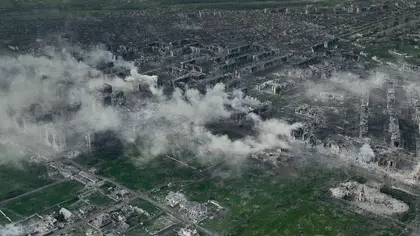Ukrainian infantry has reclaimed lost ground around Bakhmut, the Donbas’ regional center, after a series of gritty, short-range attacks. Kyiv’s forces have advanced as much as a kilometer, crossing a key canal and, securing parts of the battleground city that Kremlin fought nearly six months to capture according to news reports and official statements on Tuesday, July 4.
Deputy Defense Minister Hanna Malyar in a July 3 statement said Kyiv’s troops had made its largest territorial gains near the village Klishchiivka, to the south of Bakhmut since the start of its summer offensive. She said that Ukrainian armored infantry and assault infantry units were also slowly fighting their way into strong Russian defenses to the north of the city.
Armed Forces of Ukraine (AFU) service members posting on social media reported armored carrier-riding infantry had crossed the tactically important Siviersky Donets canal to the south of Bakhmut, and at one location Ukrainian foot patrols had penetrated into built-up parts of the city itself. Multiple, but unconfirmed posts, said Ukrainian assaults had advanced as much as a kilometer capturing Russian weapons, ammunition and prisoners of war in the process.
General Oleksandr Syrsky, commander of the Armed Forces of Ukraine (AFU) ground component, visited position close to the front-line in the Bakhmut sector on Monday July 3. Russian units were attempting counterattacks to recover the ground they had recently lost to advancing Ukrainian forces, he said.

N. Korean Troops Massed in Russia to Enter Ukraine War ’Soon’: Pentagon Chief
“The Bakhmut front has become an arena of active hostilities again. It’s pretty hot there right now. Both sides are trying to seize the initiative in order to turn the situation in their favor. The enemy is desperately clinging to positions and strongholds that were formerly occupied by Wagner Group fighters… events unfold and change very rapidly, with some positions changing hands twice a day,” Syrsky said, in comments reported by the Ukrainska Pravda magazine.
Syrsky said Russian forces on Monday attempted, unsuccessfully, to recover positions lost near Chasiv Yar, to the west of Bakhmut. Kyiv’s troops are digging in, will hold their positions, as Ukrainian attacks deeper into the Bakhmut sector will continue, he said. A Monday statement issued by Ukraine’s Army General Staff (AGS) echoed Syrsky’s official line.
“On the flanks of the city of Bakhmut, our troops continue to put pressure on the enemy, knocking them out of previously captured positions. They are successful, fortifying themselves. The enemy is resisting and suffering heavy losses,” the AGS statement said in part.
Russian scorched earth tactics and human wave assaults against die-hard Ukrainian defenses left Bakhmut practically destroyed in almost six months of bitter fighting. Kremlin forces declared the city “victoriously liberated” at the end of May. Moscow officials later admitted the casualty toll for capturing the city was at least 20,000 men, making Bakhmut the bloodiest single battle of the Russia-Ukraine War, by a substantial margin.
According to the Kremlin official narrative, Ukrainian loss of Bakhmut was the most important Russian victory since the outset of the war. According to independent analysts, the city’s capture was for Moscow a classic definition of a Pyrrhic victory.
The now departed Wagner Group, a mercenary company once directly and lavishly financed by the Kremlin, was the backbone of Russian assaults on Bakhmut and suffered most of the casualties. Recent Ukrainian advances around the Bakhmut sector came on the heels of that formation’s departure from the sector and, subsequently, Wagner’s open mutiny against Russian army leadership.
According to Russian and Ukrainian military information platforms, a hodge-podge of Russian regular army infantry units, including both professional airborne infantry and poorly-trained reserves, replaced Wagner formations in the Bakhmut sector in early June.
Ukrainian military information platforms identified the 3rd Assault Brigade, the 22nd and 28th Mechanized Infantry Brigades and the 80th Air Assault Brigade as formations spearheading recent successful attacks in the Bakhmut sector. Syrskiy said bombardments by US-made M-109 howitzers operated by gunners from 17th Tank Brigade gave critical support to those infantry-heavy assaults.
The 22nd is a newly raised brigade partially equipped with NATO heavy weapons and trained by NATO instructors. The 28th and the 80th are longstanding formations with fighting experience against Russia dating back to 2014, and the Kyiv-raised 3rd and Krivyi Rih-homebased 17th have been in continuous combat since the first days of the war.
In the southern Zaporizhzhia sector, the Ukrainian army top command led off its attacks not with veteran troops, but mostly with newly raised units lavishly kitted out with top tier heavy weapons including German Leopard 2 tanks, the French AMX-10 reconnaissance vehicles and the US-made Bradley infantry fighting vehicles and Stryker armored troop carriers.
Despite optimism in Kyiv for a breakthrough in the south, and despite their western gear, units fighting in the Zaporizhzhia sector have advanced more slowly than less well-equipped troops fighting in the Bakhmut sector.
You can also highlight the text and press Ctrl + Enter






